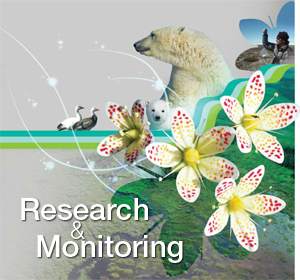
Research and monitoring
Wapusk National Park
 Research and monitoring
Research and monitoring Research and monitoring programs are important tools to understand our ecological resources. They allow scientists to study species within the park. This helps us determine whether they are unique to this landscape or are acting in a way not seen elsewhere.
Current research projects in Wapusk include:
- Ecology and population dynamics of common eiders at La Pérouse Bay, Dr. Robert Rockwell (American Museum of Natural History)
- Ecology and habitat impact of snow geese at La Pérouse Bay and on the Cape Churchill Peninsula, Dr. Robert Rockwell (American Museum of Natural History)
- Habitat assessment in the Thompson point region of Wapusk National Park, Dr. Robert Rockwell (American Museum of Natural History)
- The Expansion of lesser snow goose nesting in Wapusk National Park, Dr. Robert Rockwell (American Museum of Natural History)
- Management of Southern Hudson Bay Population of Interior Canada Geese, Brian Kiss (Province of Manitoba)
- Mechanisms underlying post-breeding migratory behaviour of shorebirds breeding near Churchill, Manitoba, Dr. Erica Nol (Trent University)
- Examining fox interactions and movements at the Arctic’s edge, Dr. James Roth (University of Manitoba)
- Influence of snow enhancement and nutrient additions by Arctic foxes on tundra plants at the Arctic’s edge, Dr. James Roth (University of Manitoba)
- Investigating Arctic fox food web interactions, Dr. James Roth (University of Manitoba)
- Hydroecology of lakes in Wapusk National Park - Sustainable ecological integrity monitoring and research, Matt Webb (Parks Canada)
- Microclimate, snowpack, treeline dynamics, and permafrost degradation in Wapusk National Park, Manitoba, Dr. Steve Mamet (University of Saskatchewan)
- The ecology, population dynamics, and status of polar bears (Ursus maritimus) in relation to environmental change, Dr. Nick Lunn (Environment and Climate Change Canada)
- Determining the future of polar bears in a warming world - Understanding the behaviour and energetics associated with increased land use, Dr. Karyn Rode (United States Geological Service)
- Identifying the drivers of polar bear-human interactions, Dr. Doug Clark (University of Saskatchewan)
- Evaluation of abundance, spatial distribution, foraging and genetic structure of polar bears in Wapusk National Park using passively sampled hair and feces, Dr. Robert Rockwell (American Museum of Natural History)
- Field Measurements of Cape Churchill caribou populations habitat, Dr. Ryan Brook (University of Saskatchewan)
- Monitoring caribou winter range in the Hudson Bay Lowlands of Manitoba, Dr. Ryan Brook (University of Saskatchewan)
- Cape Churchill caribou post-calving classified count survey, Russell Turner (Parks Canada)
Monitoring programs allow scientists to assess how systems are changing over time. This allows us to determine if the changes are natural or due to human impacts. Through monitoring, we can understand if our management actions are effective.
Wapusk National Park has developed an ecological integrity monitoring program (EIMP), which:
- Monitors the impacts of climate change and other stressors on the local ecosystems within the park and greater park region;
- Aims to maintain or restore the integrity of the ecosystems;
- Monitors ecological aspects, like permafrost, hydrology and snowpack conditions;
- Monitors snow geese and polar bears’ population dynamics, and vegetation change;
- Aims to build a baseline of data that can detect change, direction and magnitude;
- Aims to determine a way forward for conservation and restoration within the park;
- Works in partnership with external organizations, such as researchers, provincial government, and Indigenous stakeholders.
Communication is an important aspect of research and monitoring efforts. Information gets shared to make other researchers aware of the projects happening in the park.
Annual Report of Research and Monitoring 2015-2016 (PDF, 4.2 MB)
Annual Report of Research and Monitoring 2011-2012 (PDF, 4 MB)
Annual Report of Research and Monitoring 2010-2011
The Wapusk National Park Management Plan highlights Parks Canada’s responsibility for maintaining and monitoring ecological integrity in the Park. Collaborations with universities, government agencies and not-for-profit organizations enhance our collective ability to measure the critical issues that may affect ecological integrity in the Park and surrounding area, and to better understand them.
Churchill Northern Studies Centre (CNSC), Parks Canada staff and researchers met in January 2011 in Winnipeg to share scientific research findings and develop ideas for future research priorities in the greater Churchill region. Following this successful symposium, CNSC worked with Parks Canada to produce the 2011 Annual Report of Research & Monitoring for Wapusk National Park. The report, which provides summaries of research being conducted in and around the park, can be found at the following link: Annual Report of Research and Monitoring in the Greater Wapusk Region 2010-2011
Annual Report of Research and Monitoring 2009-2010 (PDF, 3 MB)
Annual Report of Research and Monitoring 2007-2008 (PDF, 2.43 MB)
The Birds of Wapusk National Park. 2009. Occasional Paper No. 1. (PDF, 3.9 MB)
Related links
- Date modified :